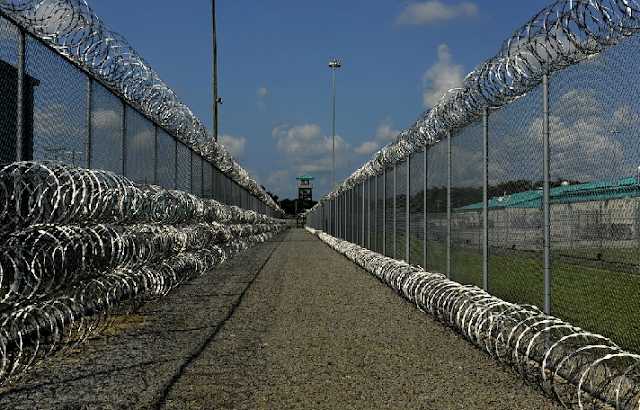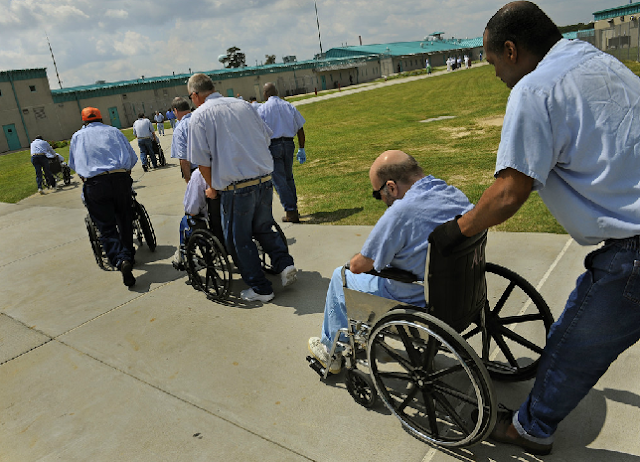4 – 10 – 2011
Deerfield Correctional Centre
A warm welcome was presented by:
- Keith W Davis, Warden
- Clyde Alderman, Assistant Warden
- Susan Bolton, Business Manager
- Teresa Porrovecchio, Operations Manager
- Darleen Ellsworth, Programs Manager
- Bonita Badget, Registered Nurse Coordinator
- Beth Cabell, Programs (Farms, Reentry, Education) (compassionate release study)
- Darlene Elsworth, Programs ID Awareness, VETS support, SOM, outcome measures
- Kathy Walker, Unit Manager, Special Needs 57B
- Meredith Wran Psychologist (Psych Associate)
- The Doctor
- John Beale, Recreational Therapist
The current Deerfield facility began receiving prisoners in 1999. It was designed to house geriatric offenders, security level 2 (scale 1 – 5 )low = low). There was no doubt Deerfield is a prison. The dual cyclone fencing and razor wire make sure you are aware of that. Entry is through a secure system of checks and metal detection. I noted, for the first time of one of these visits that my feet were x-rayed as evidenced on the screens as I passed through the security area. (I saw the metal rods in the shoes I was wearing on the screen)
The growth of ageing prisoners and their associated medical needs has been a challenge for most populations / states within the USA and further expansion of the facility was needed and was completed in 2007. The current facility holds approximately 1100 inmates. The average age of inmates is 56 years: 46% = 51-60; 26% = 41-50; 18% = 61-70. The oldest offender is 89 years of age. Approximately 800 prisoners are on prescribed medication. There is a full time medical specialist (see comments later); well organised nursing staff with RN1, RN2, & PCA (Australian equivalent); An inmate support model was also adopted where younger physically able inmates supported older prisoners under the supervision of nurses / paid carers.
The key areas of interest were the 57 bed dormitory style assisted living unit and the 18 bed infirmary. On first reflection a dormitory may look and sound somewhat inhospitable when compared to a single or shared cell; but interestingly and quite paradoxically the dormitory environment offered warmth, comfort and support; that is not as evident in a structured cell environment, within the prison systems I have seen thus far.
Inmates and staff were noted to exchange discussions reasonably freely. (The author notes the impact a visitor/ foreigner has on an environment such as this). Beds were mostly fixed metal beds of two heights (high or low); there were also some hospital type high low beds (about 7) on one wing of the dormitory. (Again, these were hospital style High Low Beds; not the aged care type that can lower all the way to the floor)
All grounds were noted to be level and on the ground floor. There were no stairs or trip hazards present and importantly, there was easy access to the outside: for feeling the sun light on your face, breathing in fresh air, seeing the blue sky and clouds and seeing some green foliage (albeit through dual cyclone fences).
The 18 bed infirmary operated like a small hospital / emergency unit and was staffed 24/7 with registered nursing staff. There appeared to be a good triage system where inmates requiring more intense medical support were transferred to the local Southhampton Memorial Hospital (about 20 miles away) where “13 secure beds” were provided; as well as having a number of outpatient clinics for prisoners. Deerfield provide security staffing for the Hospital (at Deerfield’s expense) Of course this also means transport coordination for each prisoner. (Transport arrangements were not observed) Earlier that day an inmate with uncontrollable seizures had been transferred. Intravenous fluids and medications were provided in the unit but not respiratory (respirator) support. All seemed appropriate for the size, style and staffing for the unit. Pharmaceuticals were prepared off site through a provider and the Nurse in charge was very happy with the responsiveness of the service (similar to what Wintringham have with their Aged Care facilities). There are currently 801 inmates prescribed medications and about 4,500 prescriptions are filled each month. The medical budget alone for the facility is about $4 million a year.
• Total inmates = 1066
• Inmates on Medications = 801
• Wheelchair bound inmates = 50
• Medical Transportation trips during 2011 = 1614
• Emergency medical trips during 2011 = 101
Deerfield has approximately 13 offenders with a dementia diagnosis. Eight are housed in the open dormitory and 4 are in the infirmary. The need for a celled dementia specific unit is immediate and has been identified by Deerfield management as a priority; given dementia patients can be disruptive and can fall victim to other more able body prisoners. A need for additional Assisted Living Beds has also been identified; which will more than likely lead to the expansion of assisted living beds into another housing unit which will reduce the amount of double bunks available. (Prisoners identified as requiring assistance with living do not (should not) be housed in a bunk area.
All housing units had a custodial staffing overlay. The presence of the custodial staff was subtle and interactions were noted to be respectful between both parties and not overladen with power structures. These observations are difficult to measure; they are what one feels on observation. They were noteworthy to be written in this report. On commenting to the group about the custodial staff; discussions focused on the value of the custodial staff to the inmates as a comrade. It was also highlighted that the men still had time to serve for a crime that the courts had convicted them on.
The Virginia Department of Corrections (VADOC) have a four year Adult Re-entry Initiative – Strategic Plan (July 2010 to June 2014). There is a real focus on reviewing prison sentencing and re-entry practises whilst ensuring public safety in the State of Virginia. In fact, as the author was writing this he stopped to watch a CNC new documentary on Prison “Billions Behind Bars”- http://www.cnbc.com/id/44762286 . The Virginian Plan is comprehensive and has a research base overlay “to enhance public safety by offenders successfully returning to and reintegrating into our communities”.
Discharge Re-entry planning presents similar challenges to Deerfield as it has to all facilities I have thus far visited. Deerfield have a well developed process that starts six months prior to planned releases where “difficult to re-enter society cases” are presented on a monthly basis to a group which includes a number of disciplines: counsellor, medical, mental health, nursing, social work and security staff.
Strategies employed include: trying to re-engage family, visiting nursing homes, and engaging faith based groups for support. There is a reality, the same reality that is faced by Australia at present; there are a number of offenders who have no home like option to be released to. There was significant interest in me sharing what I might find in my travels. There was also fascination and interest that an aged care provider was interested in working in this space of older prisoner release. (This same fascination and “admiration” was expressed in Fishkill – “there is a need for a Wintringham in the USA”).
Deerfield staff also shared end of life stories. The reality is, some inmates will die in prison. Inmates are supported through a palliative care process. Inmates are given as much opportunity as possible for visits and involvement from family when the end of life is near. Inmates are given the choice to move from the dormitory to the infirmary. There were stories shared that the end of life process is supported with prisoner choice: the value of having your prison mates around you in your last hours (the value for the dying but also for the living in knowing that the same may happen for them.)
A well structured recreation program was evident and supported by a recreational staff member. There was a fully functioning gym and basket ball court area. There was a medical overlay to this type of recreation. Older medically challenged prisoners needed medical clearance / permission for certain activities.
It is interesting to note that at both Fishkill and Deerfield, physicians were extremely positive about their work. The work life balance was quoted as a major benefit as there was not the management and administrative burden of a private practice; and overall the interaction from Doctor to patient was seen as a far more positive experience than one could achieve in private practice.
There is no mistaking that Deerfield is a prison
57 bed dormitory
Level paths between dormitory and the infirmary - there is also plenty of sunlight / open area
when you need to get "gas" - there can be only one choice :)
An old vacated farmhouse I saw on my travels through Virginia
Typical Virginian Style Farmhouse - Cotton Fields (I could hear the Beach Boys singing)
From Franklin Virginia I have to make my way to Somerset Pennsylvania. I decide to take the beach route as it is not everyday you can drive over a bridge / tunnel structure that is over 16 miles long and was built in 1964.
I drive through the state of Maryland and into Delaware
I decide to take the beach road (Highway 1) thinking I might get some beach views like you would in Australia but ... of course the beach front is continuously built out by private concerns or hotels - amazing really
I thought I might stay in Ocean City Delaware - but there was some sort of muscle car convention in the town and I inadvertently ended up in there drive through "blocky" parade (Mustangs, Hot rods, Anything V8)in my rental Toyota Corolla (embarrassment!)
I slink out of Ocean City to Dewey Beach, Delaware (the first state) and find a bar and listen to some reggae at sunset........
After a slight breakfast and nuts and fruit for lunch I find a Pizza and...
The Crusher - A Clarksburg Shiraz, Napa, California (actually quite good with peppery overtones) .... (only 2 glasses)
Over the weekend I will dawdle to Somerset Pennsylvania, making my way through to Gettysburg, PA and then to Amish country Lancaster, PA
In readiness for a tour of the Laurel Highlands Prison, Somerset Prison, PA.
see
http://www.phillytrib.com/newsarticles/item/2840-graying-of-america%E2%80%99s-prison-population.html















Your tours sound fantastic Phill. Americans are so generous.
ReplyDeleteI'm worried that you are not eating and drinking ENOUGH. More reports from bars required. Please note - Lucinda Williams, or was it Townes van Zant, wrote a song about the Chesapeake on the Rise. I hope you are driving with an appropriate soundtrack - v. important
I have been listening to a lot of Dylan - seems appropriate for the drive
ReplyDelete